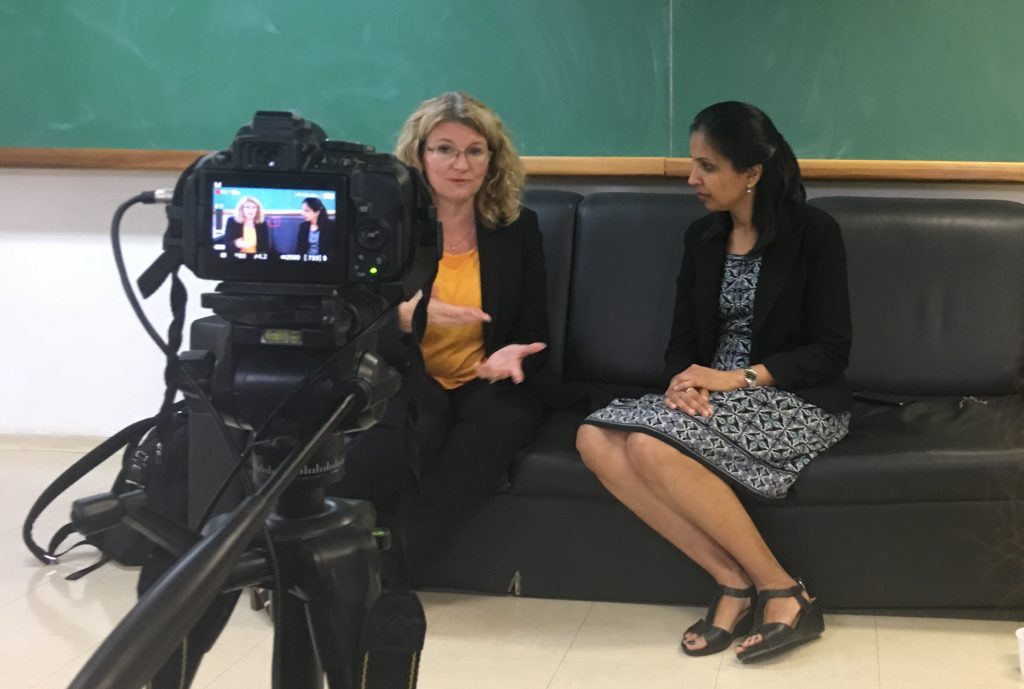
I was not sure what “biomathematicians” did, but when I looked it up I learned that I was familiar with the work, if not the more complex current techniques. You can trace the field at least as far back as John Snow (the London man who traces a cholera epidemic to a polluted well and helped create the whole science of public health, not the King of the North in “Game of Thrones”) Biomathematicians essentially map and model biological phenomenon, such as disease spread or dynamics of wildlife populations.
This I needed to know because the Mission sponsored a lecture visit by two biomathematicians – Dr Lora Billings from Montclair University and Dr Shweta Bansal of Georgetown. They were collaborating with colleague around Brazil, for us more specifically at the State University of São Paulo (UNESP). I got to have lunch and attend some lectures and a media event.
Connecting people and ideas
For the Mission, this visit satisfied a couple of our goals. First was the simple connections principle. One of the most important functions of diplomats is that we act as connectors, putting Americans in touch with counterparts in other places. Connectors play a key role in the information ecosystem but they (we) are easily overlooked or dismissed.
Women in STEM
When connecting works as it should, it grows way beyond our capacity and it is tempting to believe that it “would have happened anyway.” I am aware of this attitude because I used to share it. It was only with a fair amount of experience and some focused study that I came to appreciate the connector niche. The second of our goals, more a “meta-goal,” was to highlight women in science, in the STEM fields. Both goals were achieved.
Lots of the math was beyond me, but I did finally learn what an eigenvalue did, at least in a general sense. It is a measure of stability. The reason I bring up this piece of esoterica is that since I was in college one of my jokes (of limited use) was that in my statistics studies I learned about eigenvalues but in all my years after never saw them in action.
Modeling Disease Spread
Dr Banal talked about modelling the spread of influenza. It is not as easy as running time series, since there are many factors in complex relationship. The flu itself mutates every year and this interacts with weather, behaviors that change in relation to other factors, random chance … lots of things. She mentioned that complex is not the same as complicated and talked about how that affects ability to predict, i.e. prediction in complex systems is not possible in detail but you can model and get some ideas that can inform decisions and action.
Dynamics of Ecological Systems
Dr Billings talked about the dynamics of ecological systems, modeling what happens when you add in an invasive species or take out existing ones and/or change the dynamic as in climate change. The good news is that the impact of invasive species may be limited, in that they invade into disturbances and then may moderate. The bad news is that there are lots of disturbances these days.
Malaria Transmission
One of the Brazilian colleagues, Dr Roberto Kraenkel, talked about modeling malaria outbreaks. He had some kind of graph that could show relationships among variables that were not clearly correlated or were both correlated to other factors. Experts understand these things. For guys like me he gave a simple example. Water in a lake is correlated with rainfall in the watershed. If you know something about the watershed, rainfall may be predictive of lake levels. However, lake levels are not predictive of rainfall, but you can tie both to other factors. Even the simple example soon moved beyond my full understanding. What I got was more rain makes the lake rise – sometimes, not always.
Reality Checks
All the participants mentioned the need for boots on the ground study and they listened to local information. They were concerned that models could get ahead of reality and so built in realty checks. I thought this was great wisdom. Big data and computer power can find lots of relationships and correlations, sometimes even when they really are not there.
That is why even if your model says it is raining, it is still a good idea to look out the window.

